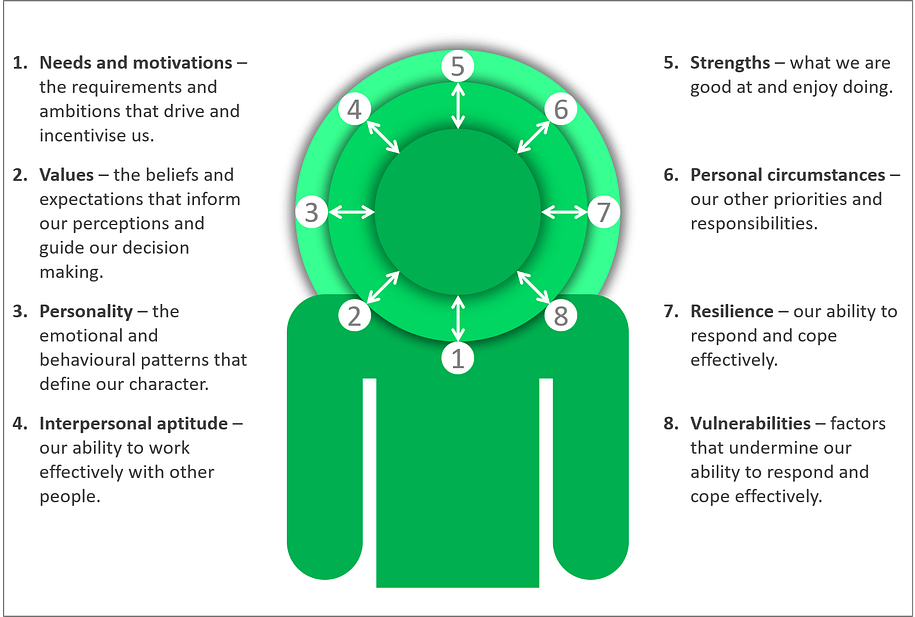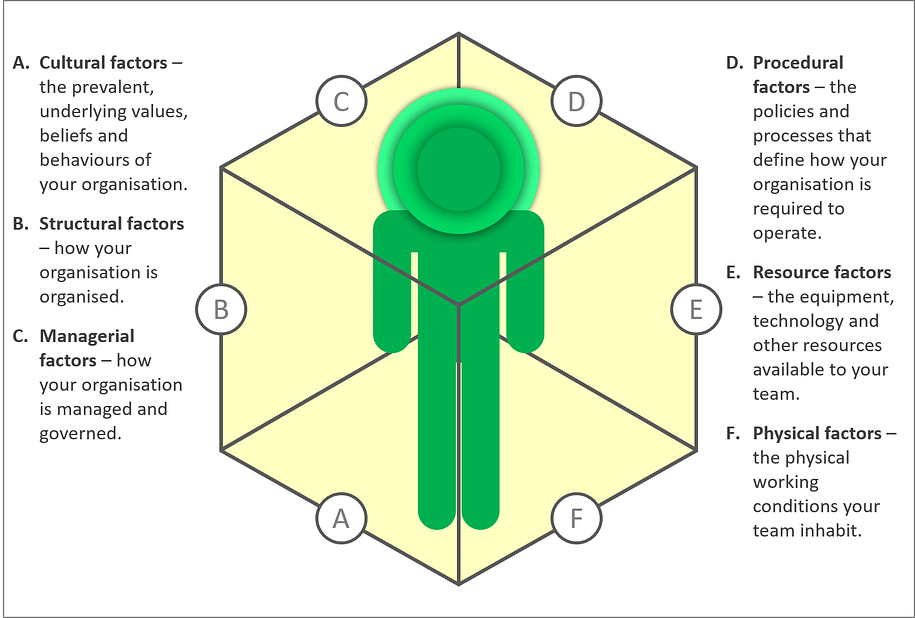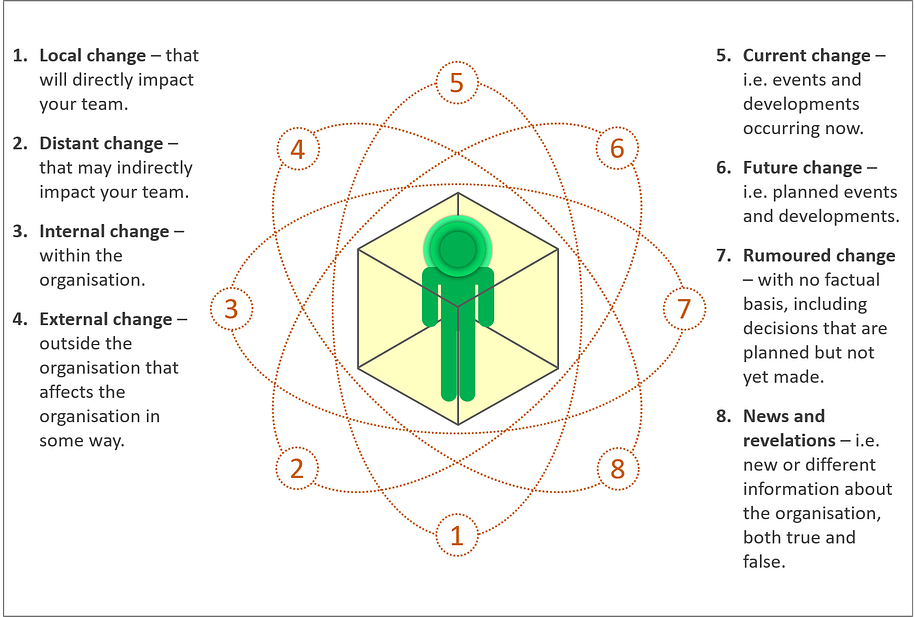
PART 4 - YOUR EMPLOYEE ENGAGEMENT LANDSCAPE
Introduction: Know your environment, inside and out
Employee engagement is constant, including its causes and impacts. It does not occur only when we focus on it.
Imagine yourself in a landscape, surrounded by people, structures, terrain features and climatic conditions. Numerous factors govern how they all exist, behave and relate to one another.
Now imagine your organisation and everything in it – all the people and places, objects and objectives, policies and processes. How they all operate, behave and relate to one another also depends on multiple interdependent and dynamic factors, including employee engagement.
Understanding how engagement dynamics permeate your organisation can help you to:
- develop engagement goals that are more meaningful and achievable;
- identify more and better opportunities for improvement;
- avoid unintended consequences;
- avoid unnecessary time/resource wastage;
- develop action plans that are more precise; and
- implement sustainable change more effectively.
We will explore your employee engagement landscape through the following three categories:
- The personal and interpersonal dimensions of each individual employee.
- The business-as-usual culture and environment in which employees are expected to operate.
- The changes that can affect the engagement equilibrium of an organisation and the people within it.
Individuals
Insight into why an individual may be or become engaged or disengaged is an invaluable resource.
Let’s reflect on what we already know. In Part 2 we looked at the distribution of engagement responsibilities across different organisational roles. First and foremost, employee engagement is as much the responsibility of the employee as it is their manager or the organisation that employs them. To be able to own their own engagement effectively, however, they will require encouragement, support and reciprocation from you.
In Part 3 we looked at taking ownership of your own engagement as a manager. If you’ve spent time reflecting on this, you’ll understand what kind of support will benefit the individuals in your team.
Why individual engagement is important
It’s easy to think of employee engagement as something that manifests at team level and above. After all, that’s usually how survey results are reported and engagement strategies developed.
However, just as optimum physical performance requires all the right parts in all the right places, behaving and functioning in the right way, so optimum team engagement depends on the adequate engagement of all team members in their own right.
As brought to our attention by the ‘Shades of Grey’ report from our research partners, Hult-Ashridge, what you may perceive as ‘team engagement’ can disguise a complex and sensitive ecosystem of engagement among and between individuals.
Employee engagement can be most easily won – and lost – at the individual level. Engaging your team as a team is important, but don’t lose sight of individual team members. Higher engagement across the team cannot compensate indefinitely for pockets of lower engagement, especially where key tasks are delivered by individuals and not shared by the team.
Factors affecting individual engagement from within
We are, each of us, psychologically complex. Everything we experience and do is influenced by how we think, feel and behave – consciously and unconsciously.
How we experience ‘work’ – how we feel about it and how we respond – is no different.
Don’t worry, we’re not suggesting that engaging managers train as occupational psychologists, but it is our recommendation that you develop a more robust awareness of what makes your people tick. Improving your insight into what may prompt someone to respond with engagement or disengagement can help you better understand how to support them and do so more easily.
Bear in mind that whilst your team will be made up of different ‘fixed’ personality types, behaviour can be adjusted over time. As managers, we can place our team members into boxes, but even the most cynical employee can become more positive if managed appropriately.
Rather than wading through all levels of detail concerning the human psyche, employment and the workplace, in the diagram below we’ve listed the aspects we consider the most relevant.

Click to enlarge image
Conditions
We thrive in the right conditions, and struggle otherwise. Aligning workplace conditions to optimise the employee experience helps engagement to thrive.
As we saw in Part 2, leaders, managers and the HR department all have responsibilities for the state of employee engagement within an organisation. However, the influence of the organisation extends far beyond the individual actions and attitudes of those in positions of authority. Look at the enablers of engagement, for example: the need for strong strategic narrative, organisational integrity and the empowerment of employee voice. These are embedded in the fabric of the engaging organisation.
Human beings are remarkably sensitive on numerous levels. It’s in our DNA. You may have heard of the ‘fight, flight or freeze’ instinct – the automatic response to circumstances that overwhelm our ability to cope. Fight-flight-freeze is an extreme example of how psychologically volatile we can be, while on a day-to-day basis we respond limitlessly to the world around us, knowingly and unknowingly. Seemingly dysfunctional behaviours are often coping mechanisms brought on by stress. As managers, it is helpful for us to be aware of these behaviours and their impact, in ourselves as well as those around us.
Every aspect of our working environment affects our bodies, thoughts and feelings, and thereby the levels and direction of our engagement.
For example:
- The refurbishment of executive offices without improvement of employee areas, which can introduce a sense of unfairness.
- The malfunctioning printer that can create delay and frustration.
- The blame culture that can inhibit innovation and feed risk aversion.
- The promotion of managers based on technical ability alone, which can undermine people management.
Aligning workplace conditions to optimise the employee experience
The foundations for solid and sustainable employee engagement require more than just compelling communication. Employees need to be physically and emotionally aware and satisfied that an employer’s engagement promises are genuine and will be delivered. Every aspect of the organisation should be aligned to engagement as closely as possible.
At the very least, care should be taken to keep disengaging factors to a minimum.
While your authority and opportunities to influence organisational factors may be limited, you should strive to:
- understand what aspects of your organisation especially encourage or inhibit the engagement of your team, including why and how (for example: issues concerning how accessible something is and whether it’s fit for purpose and considerate of employees);
- identify those aspects within your immediate control, those over which you have a degree of influence and those entirely outside of your influence; and
- increase or mitigate their impact as best you can, either by working to change them or by providing your team with appropriate support.
In the diagram below, we feature what we consider to be the principal categories of workplace conditions. Think about what falls into these categories within your local work environment.

Click to enlarge image
Events
Change is a defining theme of our time. It could be argued that change is now so common that it belongs above in the categories of workplace conditions. However, on an individual level at least, we are not yet so familiar with change as to have become desensitised to it. Change is not ‘background noise’ and can represent a unique challenge.
In the context of your employee engagement landscape, when we talk about ‘events’ we’re talking about specific changes that affect employee experiences and employee perceptions.
It’s worth bearing in mind that, for individual employees, the relevance of any given change is totally subjective. For an organisation, the disposal of an entire business unit is far more impactful than the resignation of a single team leader, while the opposite may be true for an employee if it is their manager who has chosen to leave. At the same time, while senior leadership may take public criticism in their stride, individual employees may be deeply affected.
No event should be overlooked or discounted regarding the impact it may have. From calling time on free coffee, cancelling the Christmas party or announcing a profit warning, to organisational restructures, forced performance curves or the death of a colleague, anything can affect anyone to an extent that may destabilise engagement.
Proposed or potential change also represents a risk. We recommend you pay careful attention to the word on the grapevine and any associated discussion and questions among your team.
Rumoured change is especially dangerous. The key to managing change and maintaining engagement is communication. Ensuring that employees understand change correctly is challenging enough when you control the change communication. When you have little or no control over change communication, the impact on engagement can be disastrous.
Current and future change does not always represent a threat to engagement, of course, it can also present a beneficial opportunity. If employees experience or anticipate change for the better, it can have an uplifting effect. Try to make the most of this if possible but be aware that if things don’t go as employees are hoping it can generate disengagement.
While you may not be in a position to influence every new decision and development that might impact your team, you should strive to:
- be aware of events, near and far, that could potentially impact your team in any way, including rumoured events;
- ensure you understand the proposed or decided changes;
- anticipate how your team will react and the questions they will ask;
- gather the facts on their behalf;
- plan your communication approach; and
- engage your team about the change in good time, sharing all relevant information and ensuring they understand and are appropriately prepared and supported.



